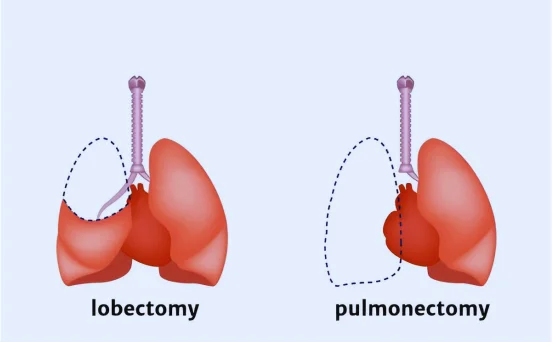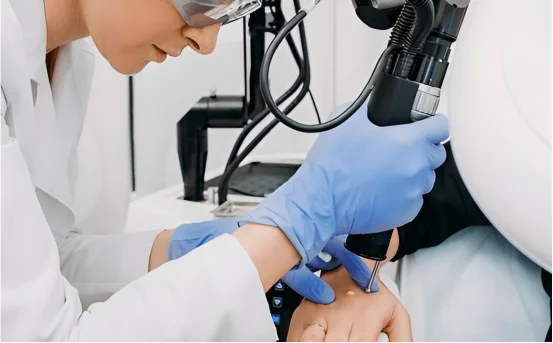Segmentectomy surgery is also called pulmonary segmentectomy. It is a precise procedure that removes a segment of lung. Segmentectomy is different from lobectomy which removes the entire lung lobe. It preserves as much lung tissue as possible.
The surgery is performed most often in early-stage lung carcinoma, benign nodules, or localized tumors that need to be removed for diagnostic or therapeutic purposes. Segmentectomy is a popular option among patients who need targeted lung resection. This is due to the advancements of minimally-invasive techniques such as video-assisted surgery or robotic-assisted procedure.
Segmentectomy is a safe and effective way to save the lungs, whether it’s for cancer treatment or benign conditions. It has fewer complications, a faster recovery time, and a better quality of life.
Why Segmentectomy Surgery is Performed
When is segmentectomy surgery most commonly performed?
- Early-Stage Lung Cancer Diagnosis:-In patients diagnosed with Stage IA non-small cell lung cancer (NSCLC), segmentectomy is a highly effective alternative to lobectomy–especially for those with compromised pulmonary function. The cancerous tissue is removed while the healthy lung tissue is left.
- Poor Lung Function:- Segmentectomy is an option for patients with lung conditions such as COPD (Chronic Obstructive pulmonary Disease) who are unable to tolerate a lobectomy.
- Benign or Suspicious nodules:- Segmentectomy is a useful tool for both diagnosis and treatment when imaging reveals a single pulmonary nodule of uncertain pathology. It ensures that the margins are not obstructed while avoiding the removal of excessive lung tissue.
- Metastatic Disease:- When cancer has spread to the lung from another organ, but it is contained within a single segment of the lung, surgeons can perform a segmentectomy either as a curative measure or symptomatic treatment.
- The Minimally Invasive Benefit:- Segmentectomy is less invasive than lobectomy. This results in shorter hospital stays and faster recovery.
- Segmentectomy Surgery Symptoms:-Segmentectomy is a surgical procedure, not a condition. However, the patients may exhibit symptoms because of the underlying conditions that require the surgery (usually lung cancer or infection).
- Cough that persists
- Chest pain or discomfort
- Shortness of Breath
- Hemoptysis is the coughing up of blood.
- Recurrent lung infections
- Noise or wheezing breathing
- Unexpected weight loss
- Fatigue or general weakness
If you experience any of these symptoms, it is important to undergo diagnostic testing in order to determine whether a lung segmentectomy (or another surgical intervention) is required.
Segmentectomy surgery is required for certain conditions
Segmentectomy can be performed to treat underlying diagnoses or causes, including:
- Non-Small Cell Lung Cancer:- Segmentectomy is considered curative when cancer is contained to one segment of the lungs and is detected early.
- Benign Lung Nodules:- On scans, non-cancerous tumors such as hamartomas and inflammatory pseudotumors may grow or appear ambiguous. This can lead surgeons to remove these growths for biopsy or prevention.
- Metastatic Lesions:- Metastases can spread from other organs to lung segments. Such lesions can be controlled or eliminated by a targeted resection.
- Tuberculosis and Fungal Infections:- Localized chronic infections, such as TB or aspergilloma can cause irreversible lung damage, which may require removal.
- Congenital Abnormalities:- Segmental removal of lung structures, such as sequestrations and bronchial atresias, is sometimes necessary to relieve symptoms or control infection.
Diagnosis – How do you determine the need for a segmentectomy?
A comprehensive diagnostic approach will be used to determine if a segmentectomy should be performed.
Image Tests
- Chest X ray is often the first test to reveal abnormalities.
- CT (Computer Tomography) scan: This provides detailed images of the lung, which are essential to locating and assessing nodules, their size, shape and location.
PET (Positron-Emission Tomography) detects metabolic activity, and can help differentiate benign from malignant lesions.
- Bronchoscopy:-Use to visualize the airways, and collect tissue or liquid samples.
- Biopsy:-A biopsy by needle or surgery can confirm if a growth is malignant and help guide treatment.
- Pulmonary Function Tests:- Assess the lung capacity of the patient and determine whether they are able to tolerate segmentectomy, or if a less invasive treatment is needed.
- Molecular & genetic Testing:-Tests on biopsy samples for cancer can reveal genetic mutations which influence treatment and prognosis.
Treatment: What happens during segmentectomy surgery?
Pre-operative preparation
- If needed, smoking cessation and pulmonary rehabilitation
- Blood tests, ECG and anesthesia consultation
- Fasting for 6-8 hours prior to surgery
Surgical Techniques
Segmentectomy is performed by:
- Thoracotomy : Open surgery that is more traditional with a longer incision.
- VATS (Video Assisted Thoracoscopic surgery): A minimally invasive procedure with a camera that allows for precision.
- Robotic-assisted surgery: It offers greater precision, less trauma and faster healing.
During surgery, the doctor:
- Isolates and identifies the lung segment that contains the lesion
- Tie off the segmental bronchus & arteries
- Removes the target segment
- Examine surrounding tissues and lymph nodes to check for possible spread
Postoperative Care
- Hospital stay: 2-5 (depending on the surgical approach).
- You can use chest tubes to drain air or fluid
- Exercises in breathing and physiotherapy is essential
- It may take several weeks for full recovery.
Conclusion
Segmentectomy surgery is a tissue-preserving, tailored solution to a variety of lung conditions – from early-stage cancers and benign nodules. The precision of the surgery makes it a great option for patients who need intervention, but still want to maintain as much lung function as they can.
Segmentectomy has become a popular option for thoracic and pulmonologists around the world as minimally-invasive techniques have improved.
Consult a thoracic surgeon if you have a concern about your lung health or a suspected pulmonary nodule. The results of a thorough evaluation will determine if segmentectomy surgery would be the best and most beneficial option.























